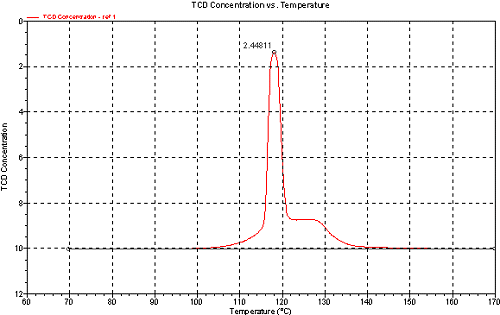全自动化学吸附仪
仪器型号:Autochem 2920 美国MICROMERITICS公司产品 2002年购置
照片
![]`JI%85S}0ZT@`8AOER5NVO.jpg](/brici/pro_service/la_equipment/PublishingImages/20170209/img_20170209_539789478586.jpg)
主要技术参数:程序升温范围:室温—1100℃
化学吸附质: CO、H2、NH3、O2等多种气体
及吡啶、水等多种液体
载气:He, Ar, 制备气:H2, O2, He, Ar,
气体流速: 手动控制0 to 100 mL/min*(H2)
自动控制10 to 75 mL/min
应用领域:
程序升温脱附, 用于吸附物种脱附状态的测定,可利用此功能进行表面酸的强度及总酸量的测定;
程序升温还原, 用于还原温度测定;
程序升温氧化, 用于氧化情况测定;
脉冲化学吸附, 用于化学吸附量的测定
应用:

Figure 1. Temperature-Programmed Desorption profiles from TPD analyses of Pyridine onZSM-5 and Ca-ZSM-5.
Zsm-5和Ca-ZSM-5程序升温吡啶脱附曲线

Figure2. Temperature-Programmed Reduction profile of metal oxide.
金属氧化物的程序升温还原曲线
Automated CatalystCharacterization System
Type:AUTOCHEM Ⅱ2920 Mic.company, U.S.
Specifications:Temperature system: Ambient to 1100°C
Gases: Loop (Analysis): H2, CO, O2, NH3 vapors suchaspyridine, water, etc.
Carrier: He, Ar, and other gases
Preparation: H2, O2, He, Ar, and others
Gas Flow Rate: All Mass Flow Controllers(MFCs)
Manual Control: 0 to 100 mL/minute*
Automatic Analysis: 10 to 75 mL/minute
*Rate for Hydrogen; other gases have a different range.
Application: Temperature-ProgrammedDesorption (TPD)analyses determine the number, type, and strength of activesites available onthe surface of a catalyst from measurements of the amounts ofgas desorbed atvarious temperatures.
Temperature-ProgrammedOxidation (TPO) examines the extentto which a catalyst can be oxidized or theextent to which it was previouslyreduced.
Temperature-ProgrammedReduction (TPR) determines thenumber of reducible species present on thecatalyst surface and reveals thetemperature at which the reduction of eachspecies occurs.
PulseChemisorption determinesactive surface area, percentmetal dispersion, and active metal particle sizeby applying measured doses ofreactant gas to the sample.


